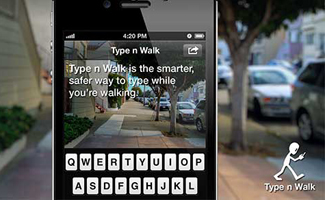Texting While Walking: More Dangerous Than You Think
Many states have made text messaging while driving a jail-time or high-fine offense after numerous deadly accidents caused legislators to take action. But with all the ensuing publicity, another downside of texting went overlooked. Did you know that texting while walking can be just as dangerous?
Just ask San Franciscan Katie Winslow*. She was walking across a busy downtown intersection, immersed in a text with her girlfriend, when she fell into a well-marked construction ditch. She’s out of her leg cast now. She was lucky.
While it might seem to be a no-brainer task to talk or text on a cellphone while walking, mounting accident statistics from towns and cities across the U.S., along with various university research studies, prove otherwise. Texting while walking resulted in so many fatal or near-fatal incidents that this past May the police chief of Fort Lee, N.J., ordered his officers to start handing out $85 tickets to people texting while jaywalking.
That hubbub resulted in the press incorrectly reporting that the Fort Lee law prohibited texting while walking. Fort Lee Police Chief Thomas Ripoli corrected the reports, saying fines were only levied against jaywalkers, noting the increasing numbers of pedestrian crashes — more than 40 so far this year — caused by distracted “texters.” “People are texting on their cellphones and not paying attention,” Ripoli said.
Studies Show Real Danger
“We were surprised to find that talking and texting on a cellphone were so disruptive to one’s gait and memory recall,” said Dr. Eric M. Lamberg, clinical associate professor at the school of Health Technology and Management at Stony Brook University.
Participants, all cellphone users in their 20s, were shown a target 8 meters away. Then, with the vision of the target and the floor obstructed, they were instructed to walk at a comfortable pace to the target. After each of three walks, researchers measured the time it took and where each person stopped.
Sign up to receive The Snapshot, a free special dispatch from Laptop Mag, in your inbox.
A week later, the task was repeated, but the participants’ vision was blocked except for the ability to see a cellphone for either talking or texting. Participants who were texting while walking veered off course 61 percent more and overshot the target 13 percent more, compared with the previous week’s baseline tests.
Lamberg said areas in the brain controlling executive function and attention are also necessary for walking. The study revealed that significant reductions in velocity and difficulty maintaining course indicates cellphone use and texting impacts working memory of these tasks.
The study’s co-author, Dr. Lisa Muratori, clinical associate professor at Stony Brook’s Department of Physical Therapy, noted that the study is guiding researchers to understand just what mechanism causes the difficulty of walking and using a cellphone simultaneously. “People need to be aware that they are impacting their safety by texting or talking on the cellphone while walking. I think the risk is there,” said Lamberg.
This Is Your Brain On Texts
Another study, this one conducted by Jack Nasar, an Ohio State University professor, found that pedestrians talking or texting on cellphones were much more likely to walk in front of cars than those not using phones.
In his research, Nasar discovered that more than 250 people arrived at Ohio emergency rooms to treat injuries incurred while walking and using a cellphone or other mobile device. He concluded that, “for pedestrians as with drivers, cognitive distraction from mobile phone use reduces situation awareness, increases unsafe behavior, putting pedestrians at greater risk for accidents and crime victimization.”
David Schwebel, a professor who studies the problem at the University of Alabama at Birmingham, explained, “Walking actually involves a fair amount of complexity. Our brain has to work hard to make sure we walk safely, especially near traffic. Our brain also has to work hard to text message.” In other words, your brain can only do so much at once.
The Nanny State Excuse
Attempts by local and state politicians to get texting-while-walking bans on the books have repeatedly failed. Probably the best reason why lawmakers refuse to pass such legislation is typified by what transpired in Utah last year.
When the Utah Transit Authority created an ordinance subject to a $50 fine preventing pedestrians from using cellphones and other distracting mobile devices while crossing its Salt Lake City light-rail tracks, the state legislature refused to make it a statewide law. As Republican Utah State Rep. Craig Frank proclaimed, “I never thought the government needed to cite me for using my cellphone in a reasonable manner.”
Citing texting-while-walking laws as creating a so-called “nanny state,” such bills were D.O.A. in Arkansas and Illinois, and repeatedly killed in the New York legislature. This is in spite of the fact that psychological research studies conducted at such far-ranging universities as New York’s Stony Brook, the University of Alabama and Ohio State University demonstrate that so-called “nanny state” laws prevent deaths.
An App For That
A recent study showed 65 percent of people text while walking. In the 13- to 17-year-old age range, that number jumps to 73 percent. While it may or may not be the government’s domain to protect you from yourself, people are aware it can be dangerous. If you’re simply unwilling to keep that phone in your pocket for a few seconds, you could always try a new breed of texting app.
Type n Walk ($0.99) for iPhone displays a transparent screen that taps into your iPhone’s camera to show you what’s in front of you. On top of the environmental screen, you can compose and send SMS, email and tweets. The app claims that the transparency, combined with your peripheral vision, may help you avoid running face-first into a tree.
Similarly, WalkNText for iPhone or Walk and Text for Android (both developed by Incorporate Apps) feature a transparent screen that can be launched behind any other app, so you can see the stairs you’re about to fall down ahead of time. For $0.99 for iOS and $1.99 for Android, this app also supports voice to text, features an LED flashlight for walking in dark alleys and works in landscape mode.
Transparent Screen, a free Android app, takes transparency even further and makes the entire Android experience see-through. You can adjust the transparency level to your desired visibility. That way, whether you’re typing, reading email, downloading a new app or checking the weather, you can easily avoid uncovered manholes, children, other people and, of course, traffic accidents.
*Name has been changed.



